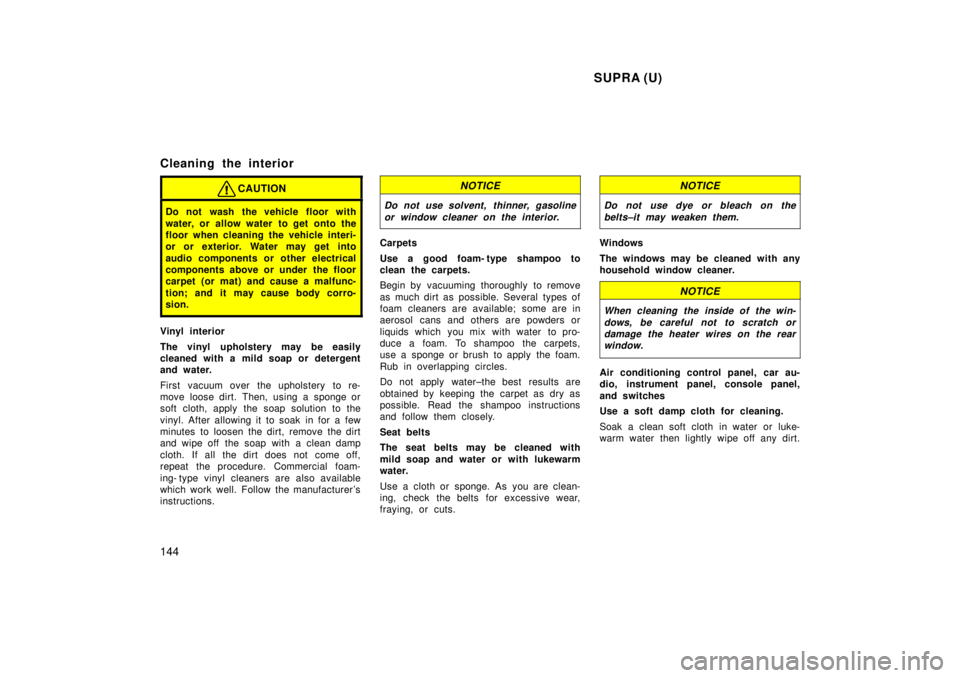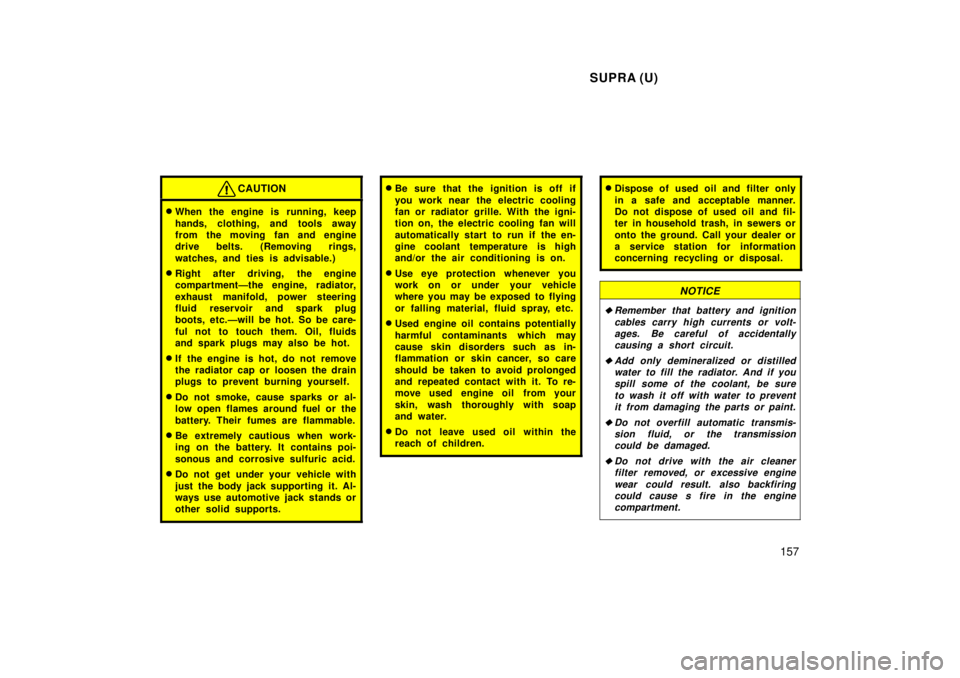1998 TOYOTA SUPRA air conditioning
[x] Cancel search: air conditioningPage 97 of 191

SUPRA (U)97
Heating
For best results, set controls to:
For automatic operation
'
Press in the ºAUTO º button.
Temperature ' To the desired
temperature
Air conditioning ' OFF
For manual operation '
Fan speed ' To the desired fan speed
Temperature ' To the desired
temperature
Air intake ' FRESH (outside air)
Air flow ' FLOOR
Air conditioning ' OFF
� For quick heating, select recirculated
air for a few minutes. To keep the
windows from fogging, select fresh af-
ter the vehicle interior has been war-
med.
� Press the ºA/Cº button on for dehumidi-
fied heating.
� Choose floor/windshield air flow to heat
the vehicle interior while defrosting the
windshield. Air conditioning
For best results, set controls to:
For automatic operation
'
Press in the ºAUTO º button .
Temperature ' To the desired
temperature
Air conditioning ' ON
For manual operation '
Fan speed ' To the desired fan speed
Temperature ' To the desired
temperature
Air intake ' FRESH (outside air)
Air flow ' PANEL
Air conditioning ' ON
� For quick cooling, move the air intake
selector to recirculate for a few min-
utes. Ventilation
For best results, set controls to:
For automatic operation
'
Press in the ºAUTO º button .
Temperature ' Towards low
temperature
Air conditioning ' OFF
For manual operation '
Fan speed ' To the desired fan speed
Temperature ' To w a r d s low
temperature
Air intake ' FRESH (outside air)
Air flow ' PANEL
Air conditioning ' OFF
Page 129 of 191

SUPRA (U)129
If your vehicle overheats
If your engine coolant temperature
gauge indicates overheating, if you ex-
perience a loss of power, or if you hear
a loud knocking or pinging noise, the
engine has probably overheated. You
should follow this procedure...
1. Pull safely off the road, stop the ve- hicle and turn on your emergency
flashers. Put the transmission in ºPº
(automatic) or neutral (manual) and ap-
ply the parking brake. Turn off the air
conditioning if it is being used.
2. If coolant or steam is boiling out of the radiator or reservoir, stop the engine.
Wait until the steam subsides before
opening the hood. If there is no coolant
boiling over or steam, leave the engine
running.
CAUTION
To help avoid personal injury, keep
the hood closed until there is no
steam. Escaping steam or coolant is
a sign of very high pressure.
3. Visually check to see if the engine drive belt (fan belt) is broken or loose.
Look for obvious coolant leaks from the
radiator, hoses, and under the vehicle.
However, note that water draining from
the air conditioning is normal if it has
been used.
CAUTION
When the engine is running, keep
hands and clothing away from the
moving fan and engine drive belts.
4. If the engine drive belt is broken or thecoolant is leaking, stop the engine im-
mediately. Call a Toyota dealer for as-
sistance.
5. If the engine drive belt is O.K. and there are no obvious leaks, you may
help the engine cool down more quickly
by running it at about 1500 rpm for a
few minutes with the accelerator pedal
lightly depressed.
6. Check the coolant reservoir. If it is dry, add coolant to the reservoir while the
engine is running. Fill it about half full.
CAUTION
Do not attempt to remove the radiator
cap when the engine and radiator are
hot. Serious injury could result from
scalding hot fluid and steam blown
out under pressure.
7. After the engine coolant temperaturehas cooled to normal, again check the
coolant level in the reservoir. If neces-
sary, bring it up to half full again. Seri-
ous coolant loss indicates a leak in the
system. You s hould have it checked as
soon as possible at your Toyota dealer.
Page 144 of 191

SUPRA (U)
144
Cleaning the interior
CAUTION
Do not wash the vehicle floor with
water, or allow water to get onto the
floor when cleaning the vehicle interi-
or or exterior. Water may get into
audio components or other electrical
components above or under the floor
carpet (or mat) and cause a malfunc-
tion; and it may cause body corro-
sion.
Vinyl interior
The vinyl upholstery may be easily
cleaned with a mild soap or detergent
and water.
First vacuum over the upholstery to re-
move loose dirt. Then, using a sponge or
soft cloth, apply the soap solution to the
vinyl. After allowing it to soak in for a few
minutes to loosen the dirt, remove the dirt
and wipe off the soap with a clean damp
cloth. If all the dirt does not come off,
repeat the procedure. Commercial foam-
ing- type vinyl cleaners are also available
which work well. Follow the manufacturer 's
instructions.
NOTICE
Do not use solvent, thinner, gasoline
or window cleaner on the interior.
Carpets
Use a good foam- type shampoo to
clean the carpets.
Begin by vacuuming thoroughly to remove
as much dirt as possible. Several types of
foam cleaners are available; some are in
aerosol cans and others are powders or
liquids which you mix with water to pro-
duce a foam. To shampoo the carpets,
use a sponge or brush to apply the foam.
Rub in overlapping circles.
Do not apply water±the best results are
obtained by keeping the carpet as dry as
possible. Read the shampoo instructions
and follow them closely.
Seat belts
The seat belts may be cleaned with
mild soap and water or with lukewarm
water.
Use a cloth or sponge. As you are clean-
ing, check the belts for excessive wear,
fraying, or cuts.
NOTICE
Do not use dye or bleach on thebelts±it may weaken them.
Windows
The windows may be cleaned with any
household window cleaner.
NOTICE
When cleaning the inside of the win-dows, be careful not to scratch ordamage the heater wires on the rear window.
Air conditioning control panel, car au-
dio, instrument panel, console panel,
and switches
Use a soft damp cloth for cleaning.
Soak a clean soft cloth in water or luke-
warm water then lightly wipe off any dirt.
Page 151 of 191

SUPRA (U)151
Battery electrolyte level
Make sure the electrolyte level of all bat-
tery cells is correct. Add only distilled
water when replenishing. See Chapter 7- 3
for additional information.
Brake fluid level
Make sure the brake fluid level is correct.
See Chapter 7- 2 for additional information.
Engine oil level
Check the level on the dipstick with the
engine turned off and the vehicle parked
on a level spot. See Chapter 7- 2 for addi-
tional information.
Power steering fluid level
Check the level on the dipstick. The level
should be in the ºHOTº or ºCOLDº range
depending on the fluid temperature. See
Chapter 7- 2 for additional information.
Exhaust system
If you notice any change in the sound of
the exhaust or smell exhaust fumes, have
the cause located and corrected immedi-
ately. (See engine exhaust cautions in
Part 2.)
Be on the alert for changes in perfor-
mance, sounds, and visual tip- offs that
indicate service is needed. Some impor-
tant clues are as follows:
� Engine missing, stumbling, or pinging
� Appreciable loss of power
� Strange engine noises
� A leak under the vehicle (however, wa-
ter dripping from the air conditioning
after use is normal.)
� Change in exhaust sound (This may
indicate a dangerous carbon monoxide
leak. Drive with the windows open and
have the exhaust system checked im-
mediately.)
� Flat- looking tire; excessive tire squeal
when cornering; uneven tire wear
� Vehicle pulls to one side when driving
straight on a level road
� Strange noises related to suspension
movement
� Loss of brake effectiveness; spongy
feeling brake or clutch pedal; pedal al-
most touches floor; vehicle pulls to one
side when braking
� Engine coolant temperature continually
higher than normal If you notice any of these clues, take your
vehicle to your Toyota dealer as soon as
possible. It probably needs adjustment or
repair.
CAUTION
Do not continue driving with the ve-
hicle unchecked. It could result in se-
rious vehicle damage and possibly
personal injury.
Does your vehicle need
repairing?
Page 156 of 191

SUPRA (U)157
CAUTION
�When the engine is running, keep
hands, clothing, and tools away
from the moving fan and engine
drive belts. (Removing rings,
watches, and ties is advisable.)
� Right after driving, the engine
compartmentÐthe engine, radiator,
exhaust manifold, power steering
fluid reservoir and spark plug
boots, etc.Ðwill be hot. So be care-
ful not to touch them. Oil, fluids
and spark plugs may also be hot.
� If the engine is hot, do not remove
the radiator cap or loosen the drain
plugs to prevent burning yourself.
� Do not smoke, cause sparks or al-
low open flames around fuel or the
battery. Their fumes are flammable.
� Be extremely cautious when work-
ing on the battery. It contains poi-
sonous and corrosive sulfuric acid.
� Do not get under your vehicle with
just the body jack supporting it. Al-
ways use automotive jack stands or
other solid supports.
�Be sure that the ignition is off if
you work near the electric cooling
fan or radiator grille. With the igni-
tion on, the electric cooling fan will
automatically start to run if the en-
gine coolant temperature is high
and/or the air conditioning is on.
� Use eye protection whenever you
work on or under your vehicle
where you may be exposed to flying
or falling material, fluid spray, etc.
� Used engine oil contains potentially
harmful contaminants which may
cause skin disorders such as in-
flammation or skin cancer, so care
should be taken to avoid prolonged
and repeated contact with it. To re-
move used engine oil from your
skin, wash thoroughly with soap
and water.
� Do not leave used oil within the
reach of children.�Dispose of used oil and filter only
in a safe and acceptable manner.
Do not dispose of used oil and fil-
ter in household trash, in sewers or
onto the ground. Call your dealer or
a service station for information
concerning recycling or disposal.
NOTICE
�Remember that battery and ignition
cables carry high currents or volt-ages. Be careful of accidentallycausing a short circuit.
�Add only demineralized or distilled water to fill the radiator. And if youspill some of the coolant, be sure
to wash it off with water to preventit from damaging the parts or paint.
�Do not overfill automatic transmis-sion fluid, or the transmission
could be damaged.
�Do not drive with the air cleaner filter removed, or excessive engine
wear could result. also backfiringcould cause s fire in the engine compartment.
Page 188 of 191

SUPRA (U)189
80050F10
80050F08
Fuses (type A) 1. EFI NO.2 30 A: Multiport fuel injection
system/s equential multiport fuel injec-
tion system
2. EFI NO.1 30 A: Multiport fuel injection
system/s equential multiport fuel injec-
tion system
3. AM2 30 A: Starter system
4. FOG 15 A: Front fog lights
5. HAZ- HORN 15 A: Emergency flashers,
horns
6. TRAC 7.5 A: Traction control system
7. ETCS 15 A: Electronic Traction Control
System
8. ALT- S 7.5 A: Charging system 9. DOME 7.5 A:
Interior lights, personal
lights, door courtesy lights, luggage
compartment light, ignition switch light,
open door warning light, theft deterrent
system
10. RAD NO.1 20 A: Radio cassette tape
player
11. HEAD (RH) 15 A: Right- hand headlight
12. HEAD (LH) 15 A: Left- hand headlight
13. 30 A: Spare fuse
14. 7.5 A: Spare fuse
15. 15 A: Spare fuse
16. WIPER 20 A: Windshield wipers and
washer, rear window wiper and washer
17. HTR 7.5 A: Air conditioning system
18. ST 7.5 A: Starter system
19. IGN 7.5 A: Charging system, discharge
warning light, multiport fuel injection
system/s equential multiport fuel injec-
tion system, SRS airbag system
20. PANEL 10 A: Instrument panel lights,
instrument panel lights control
21. MIR- HTR 10 A: Mirror heaters
22. TURN 7.5 A: Turn signal lights
23. STOP 15 A: Stop lights, cruise control
system cancel device
Page 189 of 191

SUPRA (U)
190
24. CIG 15 A:
Cigarette lighter, air condi-
tioning system, SRS airbag system,
theft deterrent system, shift lock con-
trol system
25. RAD NO.2 7.5 A: Radio, cassette tape
player, power antenna
26. TAIL 10 A: Tail lights, parking lights,
front side marker lights, rear side
marker lights, licence plate lights
27. ECU- IG 10 A: Cruise control system,
anti- lock brake system, power steering,
power antenna, theft deterrent system,
shift lock control system, traction con-
trol system
28. GAUGE 10 A: Gauges and meters, ser-
vice reminder indicators and warning
buzzers (except discharge and open
door warning lights), rear window de-
fogger, charging system, cruise control
system, electronically controlled auto-
matic transmission system, traction
control system
29. ECU- B 10 A: Air conditioning system,
cruise control system, anti- lock brake
system, SRS airbag system, traction
control system
30. OBD - II 7.5A: On- board diagnosis sys-
tem Fuses (type B)
31. DOOR 30 A: Power window, power
door lock system, theft deterrent sys-
tem
32. DEFOG 30 A: Rear window defogger
Fuses (type C)
33. ALT 120 A: Charging system
34. MAIN 50 A: Starter system, headlights
35. HTR 50 A: Air conditioning system
36. FAN 30 A: Electric cooling fans
37. ABS NO.1 60 A: Anti- lock brake sys-
tem, traction control system
38. AM1 50 A: Electronic ignition system/
distributor ignition system
39. POWER 60 A: ºPANELº, ºSTOPº,
ºTAILº, ºECU- Bº, ºDEFOGº and
ºDOORº fuses